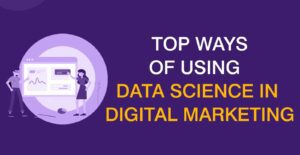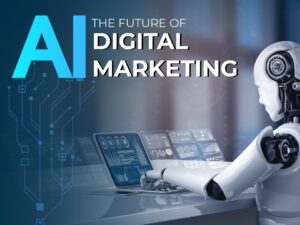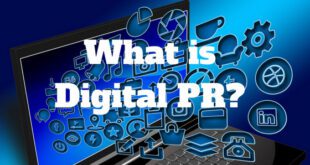
In the digital era, data science has changed the way marketers do their jobs. Now that there is a lot of data out there, marketers can use it to find useful information and make decisions that allow their businesses to grow. Data science for marketing uses statistical analysis, machine learning, and prediction models to find patterns and trends in customer data that are useful. Marketers can make focused efforts, improve their marketing strategies, and give their audience more unique experiences if they know how customers behave and how the market works. We will learn about the exciting world of data science for marketing and how it changes the way businesses talk to their customers in this piece.
What is data science in marketing?
Marketing is the process by which a company’s product or service is promoted and sold to the target market. To begin, you must gather details about your target demographic, including their interests, habits, income level, needs, and any relevant prior experiences. Scientific studies and research are done on the collected data to make it useful and worth making decisions about. Data science is useful in this situation! Data science in marketing analytics aids in determining the correct course of action and effectively communicating with target demographics. By excluding the unwanted audience, the corporation can save money and increase its profit.
6 Ways to Apply Data Science in Marketing

Here are some ways in which data science supports marketing:
1. Marketing Data Collection and Management
For marketers to use data science for marketing analytics, the first step is very important. It helps businesses figure out what to do next and sets the stage for study. Before you start collecting data, you should be clear on your goal, stop doing things that aren’t helpful, and explain why you’re collecting the data. Based on what is needed, data sources are found for things like demographics, website traffic, sales data, and social media activity.
After finding the sources, the next step is to set up ways to get the information. To do this, you can make polls or forms, add tracking codes to websites and landing pages, connect APIs to get data from other platforms, and more. Once the information is gathered, it is cleaned and reprocessed to make sure it is kept and organized properly so it can be used in the way that is needed. It’s possible to look at data well and learn more about how to use data science in marketing with this very careful process.
2. Deep Data Analysis for Marketing Trends
For marketing purposes, data science is the study of how to get useful information from large amounts of data. It involves looking at and summarizing data to find patterns, trends, and relationships. Overall, statistics help understand data structure and identify patterns.
Investigative data collection in data science and marketing analytics includes data modeling, circular segment-based analysis, trend analysis, and time series analysis. Grouping analysis arranges data based on customer preferences or campaign achievement. Correlation analysis calculates the interaction ratio to understand marketing outcomes. Time series analysis focuses on temporal patterns, trends, and seasonality.
- Text mining is beneficial for analyzing headlines and comments in social media data.
- Hypothesis testing evaluates the effectiveness of different marketing strategies using statistical tests for unbiased answers.
- Summarizing these methods provides a holistic view, guiding the extraction of valuable insights from data and enabling the development of effective marketing strategies.
3. Predictive Analytics for Marketing Forecasting
Using historical data and statistical analysis, predictive analytics in marketing aims to achieve desired outcomes. This involves capturing people’s responses, viewpoints, challenges, and expectations related to products and services. In marketing forecasting, key elements include data collection from diverse sources and thorough preparation. Essential features are selected, and predictive modeling techniques such as regression, time series analysis, random forests, decision trees, and machine learning algorithms are applied.
The data is divided into training and validation sets, with training focusing on parameter adjustments and performance enhancement. Validation measures accuracy, identifies potential issues or biases, and assesses predictive power. Then the validated data predict various scenarios. Scenario analysis and continuous data integration complete the predictive analysis process, enabling data-driven decision-making, optimization of marketing strategies, and effective resource allocation.
4. Customer Segmentation and Targeting
In marketing and digital science, customer segmentation and targeting mean putting customers into groups or categories to make targeting more effective. This method helps businesses meet specific customer needs while avoiding annoying ads. By using segments, companies can be more efficient, save money, get customers more involved, and stay true to the purpose of their brand. Data collection is the first step in the process, which then moves on to determining the segmentation variables that define the segments. These groups may be psycho-graphic, geographic, or demographic.
Segment profiling follows the process of identifying patterns and similarities to create segments. When evaluating categories, you have to think about their size, revenue, growth prospects, and how well they fit with the company’s goals. The targeting plan shows how different groups of customers will be reached, and based on their needs, actions are taken like personalizing, contact, and change. Businesses can improve their marketing and reach their target group with this all-around method by effectively addressing customer needs, preferences, and behavior.
5. Marketing Attribution and ROI Analysis
Data science for marketing analytics involves two crucial components: digital marketing attribution and ROI analysis. Digital marketing attribution focuses on measuring the impact of various marketing channels and strategies and identifying the most effective ones in terms of customer engagement, conversions, and sales. This understanding helps optimize marketing strategies and resource allocation. The collaboration between data science and marketing analytics drives these insights.
On the other hand, ROI analysis evaluates the profitability and efficiency of marketing investments. It primarily focuses on financial aspects, comparing generated revenue to marketing expenses. This analysis enhances financial performance, guides budget allocation, and aids resource planning. It exemplifies the budget-driven influence of data science and marketing analytics. Together, these components provide valuable insights to enhance marketing effectiveness, optimize strategies, and achieve better returns on investment.
5. Sentiment Analysis and Social Media Monitoring
Data science is an important part of digital marketing because it helps us understand where the brand stands and how the customer sees it. Using social media, sentiment analysis or opinion mining, you can find out how people feel in chats, comments, reviews, and other texts. Natural Language Processing (NLP) sorts text into three groups: positive, neutral, and negative. This makes it possible for tasks like market research, customer feedback analysis, and image management.
Social media marketing works on sites like LinkedIn, Twitter, Facebook, and Instagram and uses API tools to look at data in real-time or from the past. It keeps track of talks about the brand, marketing success, comments, and trends in customer behavior. This makes it easier to connect customers, study competitors, and learn more about their needs.
6. Voice of Customer (VoC) Analysis
When it comes to marketing data science, customer input is gold. It is a representation of the consumer’s opinion of a brand and what they have experienced with it. Collecting feedback is a breeze and produces a plethora of data from many clients. Deep insights into the target audience, their demands, and market trends may be gleaned from this data analysis.
For this process, data collected from a variety of places, such as sales calls, social media, polls, customer reviews, and live chat. You can use measures like the net promoter score for numeric analysis or mood analysis for qualitative analysis. Using the customer’s voice gives businesses the power to solve problems, set priorities for product development, and engage their audience through focused marketing efforts. This helps the business grow and keeps customers coming back.
Ready to Make Choices Based on Data

AI’s popularity and usability have sparked fears about job displacement, but it also offers new prospects. AI may now be used in data research without coding. Our new No-Code AI for Business Professionals course lets you learn about AI and marketing without coding. You can master data science and marketing analytics without a computer science or programming background. Explore the course now!
Frequently Asked Questions (FAQs)
How does marketing apply data science?
A. Data science is used in marketing to analyze and understand massive amounts of data, find patterns and trends. Make data-driven choices for targeted marketing campaigns, consumer segmentation, customization, and performance evaluation.
Are data scientists allowed in marketing?
A. Data scientists can market. They are essential in using data analytics, predictive modeling, machine learning, and other data science methods to enhance marketing strategies, consumer insights, and corporate development.
Q3. Should digital marketers study data science?
A. Digital marketers profit from data science. It helps them evaluate and understand data, get consumer insights, make data-driven choices, and create successful marketing plans. It improves data use for marketing performance and ROI.
 Data Science in Digital Marketing Data Science in Digital Marketing: Mechanism Examples, Benefits Data Science Meets Digital Marketing Magic
Data Science in Digital Marketing Data Science in Digital Marketing: Mechanism Examples, Benefits Data Science Meets Digital Marketing Magic
